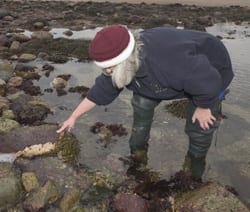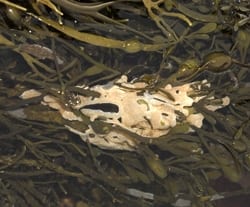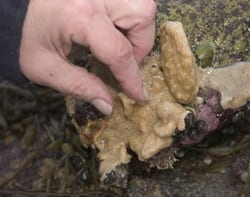Sea Squirt Invasion: Scientists Gather at WHOI for First International Conference
April 20, 2005
Scientists, natural resource managers and students from four continents will gather at the Woods Hole Oceanographic Institution (WHOI) April 21 and 22 to discuss a growing global problem: the sea squirt.
The mysterious filter feeding organism, a didemnid also known as an ascidian or tunicate because its body is covered by a tough “tunic”, first appeared in New England waters about fifteen years ago. Often resembling scrambled eggs, this invasive species grows quickly and covers clam and mussel beds, seaweed, floating docks and pilings, becoming a nuisance but also an economic threat. It has no known predators.
Simply called the “blob” by many, the organism thrives in spring and summer but can grow year round. It is spreading rapidly and is found in coastal waters from Maine to Long Island Sound and offshore on Georges Bank. Through DNA analysis, scientists have learned that the same species is living in other temperate areas around the world, from New Zealand and California to New England and the Netherlands.
“It is a global threat, and we don’t even know what species we are dealing with,” said Mary Carman, organizer of the first International Invasive Sea Squirt Conference. “There are many unanswered questions. Is it a species that has not previously been identified? Is it a species that has been described but we haven’t figured out which one? Or is it a newly evolved species?”
Carman has been studying the creatures for years, often collecting samples in Sandwich. She says didemnids can change shape and extend long tendrils when attached to pilings or floating docks. Since they are filter feeders, they use a siphon in their bodies to filter water containing plankton, bacteria and other food, which gets trapped on a mucus sheet. The water and waste is excreted through a second siphon. It is a colonial animal, comprising many individual animals called zooids, and can grow from less than an inch to about three feet.
The first International Invasive Sea Squirt Conference at the Woods Hole Oceanographic Institution (WHOI) has attracted about 100 researchers from nine nations, including Canada, New Zealand, the Netherlands, Denmark, England, Spain, Brazil, Japan, Brazil and the US. The conference is being supported by the Ocean Life Institute at WHOI, the Northeast Fisheries Science Center of the National Oceanic and Atmospheric Administration, the MIT Sea Grant program, the WHOI Sea Grant program, the US Geological Survey, and the Northeast Aquatic Nuisance Species Panel.



